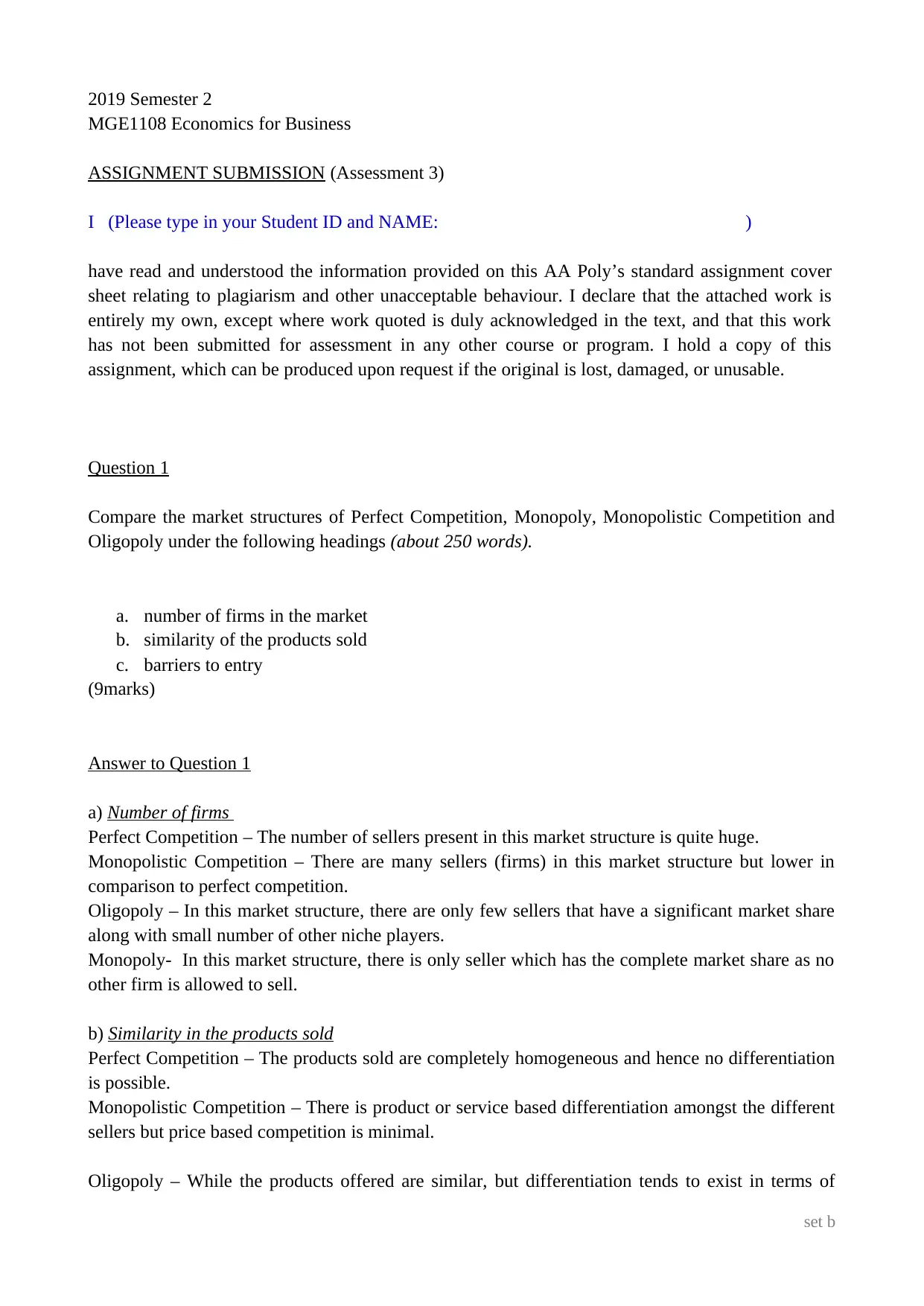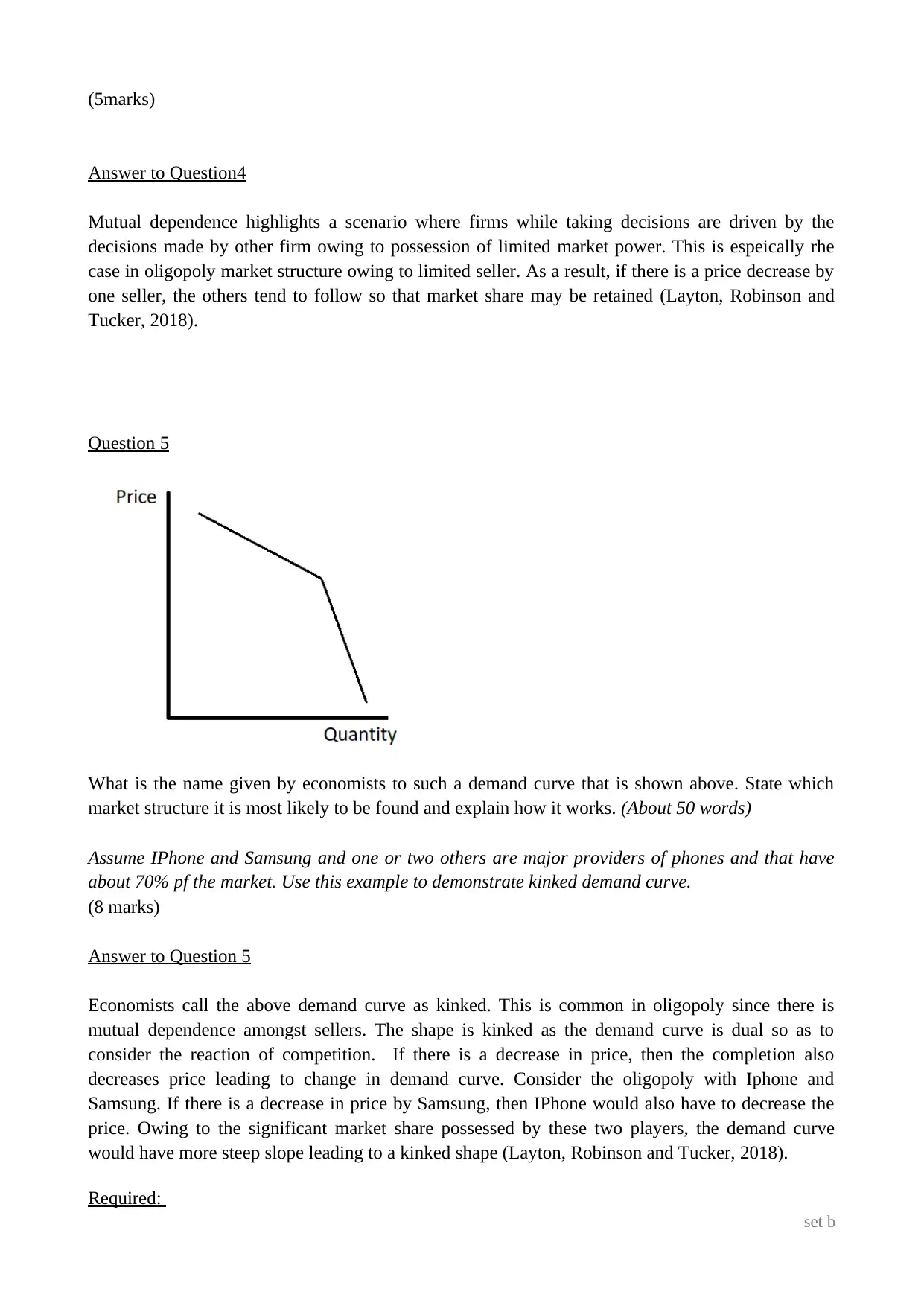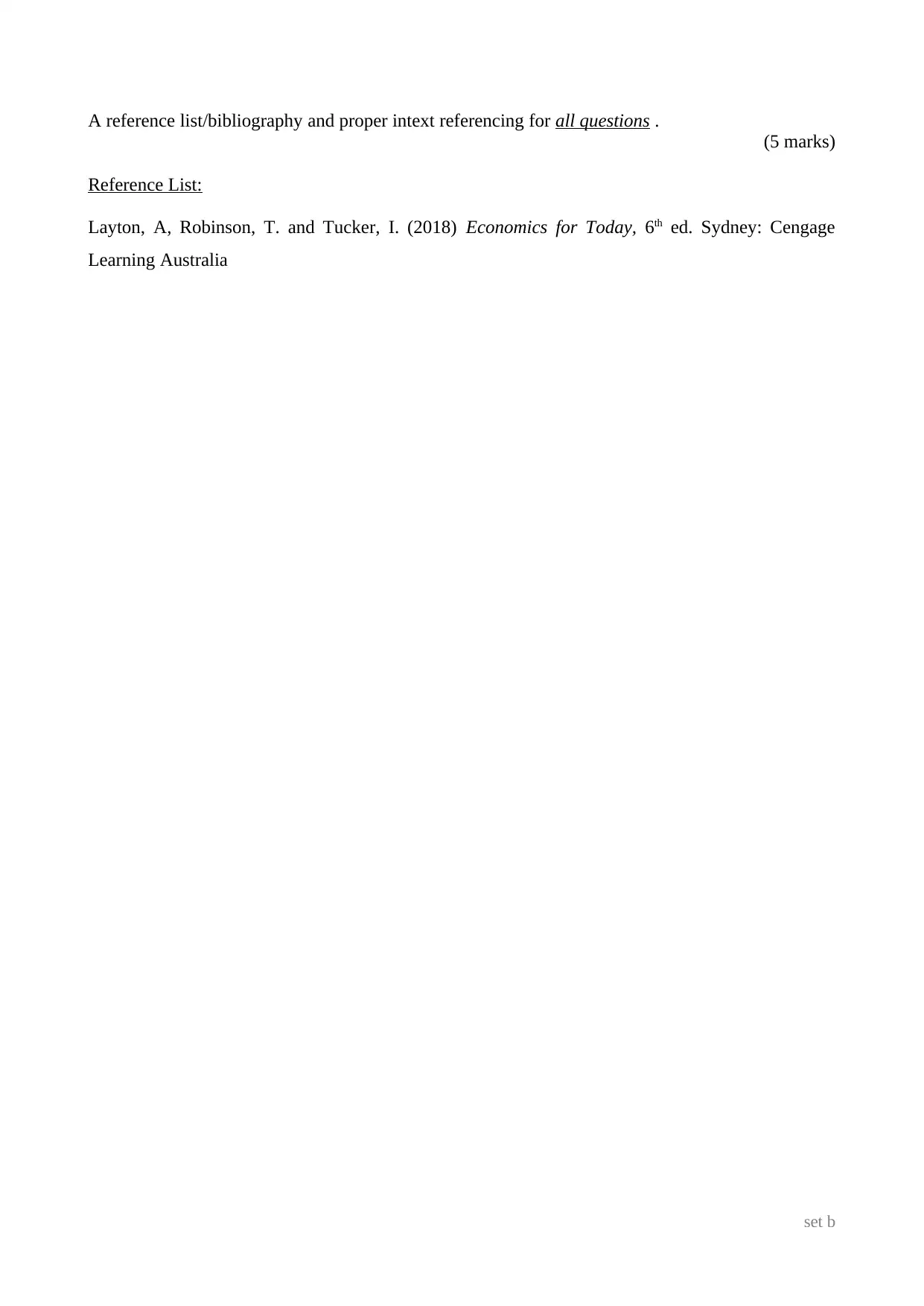AA Poly MGE1108 Economics for Business: Market Structure Assignment
VerifiedAdded on 2022/11/14
|5
|1303
|284
Homework Assignment
AI Summary
This economics assignment analyzes four market structures: perfect competition, monopoly, monopolistic competition, and oligopoly, comparing them based on the number of firms, product similarity, and barriers to entry. The assignment then applies these market structures to real-world businesses like supermarkets, casinos, and mobile phone companies, explaining the rationale behind the classifications. It further defines and provides examples of non-price competition and explains the concept of mutual dependence, particularly in the context of oligopolies. Finally, the assignment addresses the kinked demand curve, explaining its relevance to oligopolistic markets and illustrating it with the example of the mobile phone industry, specifically focusing on the competition between iPhone and Samsung. The assignment adheres to the specified formatting requirements, including in-text citations and a reference list.

2019 Semester 2
MGE1108 Economics for Business
ASSIGNMENT SUBMISSION (Assessment 3)
I (Please type in your Student ID and NAME: )
have read and understood the information provided on this AA Poly’s standard assignment cover
sheet relating to plagiarism and other unacceptable behaviour. I declare that the attached work is
entirely my own, except where work quoted is duly acknowledged in the text, and that this work
has not been submitted for assessment in any other course or program. I hold a copy of this
assignment, which can be produced upon request if the original is lost, damaged, or unusable.
Question 1
Compare the market structures of Perfect Competition, Monopoly, Monopolistic Competition and
Oligopoly under the following headings (about 250 words).
a. number of firms in the market
b. similarity of the products sold
c. barriers to entry
(9marks)
Answer to Question 1
a) Number of firms
Perfect Competition – The number of sellers present in this market structure is quite huge.
Monopolistic Competition – There are many sellers (firms) in this market structure but lower in
comparison to perfect competition.
Oligopoly – In this market structure, there are only few sellers that have a significant market share
along with small number of other niche players.
Monopoly- In this market structure, there is only seller which has the complete market share as no
other firm is allowed to sell.
b) Similarity in the products sold
Perfect Competition – The products sold are completely homogeneous and hence no differentiation
is possible.
Monopolistic Competition – There is product or service based differentiation amongst the different
sellers but price based competition is minimal.
Oligopoly – While the products offered are similar, but differentiation tends to exist in terms of
set b
MGE1108 Economics for Business
ASSIGNMENT SUBMISSION (Assessment 3)
I (Please type in your Student ID and NAME: )
have read and understood the information provided on this AA Poly’s standard assignment cover
sheet relating to plagiarism and other unacceptable behaviour. I declare that the attached work is
entirely my own, except where work quoted is duly acknowledged in the text, and that this work
has not been submitted for assessment in any other course or program. I hold a copy of this
assignment, which can be produced upon request if the original is lost, damaged, or unusable.
Question 1
Compare the market structures of Perfect Competition, Monopoly, Monopolistic Competition and
Oligopoly under the following headings (about 250 words).
a. number of firms in the market
b. similarity of the products sold
c. barriers to entry
(9marks)
Answer to Question 1
a) Number of firms
Perfect Competition – The number of sellers present in this market structure is quite huge.
Monopolistic Competition – There are many sellers (firms) in this market structure but lower in
comparison to perfect competition.
Oligopoly – In this market structure, there are only few sellers that have a significant market share
along with small number of other niche players.
Monopoly- In this market structure, there is only seller which has the complete market share as no
other firm is allowed to sell.
b) Similarity in the products sold
Perfect Competition – The products sold are completely homogeneous and hence no differentiation
is possible.
Monopolistic Competition – There is product or service based differentiation amongst the different
sellers but price based competition is minimal.
Oligopoly – While the products offered are similar, but differentiation tends to exist in terms of
set b
Paraphrase This Document
Need a fresh take? Get an instant paraphrase of this document with our AI Paraphraser

brand and price with regards to the sellers.
Monopoly- As no other seller exists in the market, hence the differentiation is assumed to be the
highest.
c) Barriers to entry
Perfect Competition – The sellers can easily enter the market as there are no barriers to entry.
Monopolistic Competition – There are some entry barriers but do not serve as a significant deterrent
for new entrants.
Oligopoly – There are significant entry barriers on account of capital expenditure, branding,
presence of competitors which makes it quite difficult to enter for a new player.
Monopoly – The barriers to entry are the highest and hence no other firm may enter this market.
Question 2
Based on your understanding of each market structure described in Question 1, state which market
structure you think each of the following businesses belong to.
Explain your choice with a short description of which characteristics of the chosen maket structure
they display. Answers with no explanation will score only half the marks.
i. Aldi Supermarket in your city
ii. A tatoo parlour in your citywhich promotes itself to be perfect for females wanting tatoos.
iii. Crown Casino in Melbourne
iv. Commonwealth Bank of Australia
v. Academies Australasia Polytechnic
vi. A small store among many other similar stores in your city’s Sunday market that sellsouvenirs
that are almost identicalsuch as wallets, caps, tee-shirts, key chains.
vii. A café in Melbourne or Sydney selling fresh cakes, coffe and tea
viii. Iphone and Samsung in the mobile phone industry
(8 marks)
Answer to Question 2
i) Oligopoly market since the retail industry only has limited players (sellers) with entry barriers
being quite high.
ii) Monopolistic competition since the entry barrier is not very high and also service based
differentiation is prevalent between various tatoo parlours situated in the city.
iii) As there is limited number of casinos in Melbourne and these require permit from
government, hence this would belong to oligopoly and also there is entry barrier.
iv) Oligopoly since there are only few players in this industry owing to entry barriers being large
such as approval from regulator, high capital expenditure etc.
set b
Monopoly- As no other seller exists in the market, hence the differentiation is assumed to be the
highest.
c) Barriers to entry
Perfect Competition – The sellers can easily enter the market as there are no barriers to entry.
Monopolistic Competition – There are some entry barriers but do not serve as a significant deterrent
for new entrants.
Oligopoly – There are significant entry barriers on account of capital expenditure, branding,
presence of competitors which makes it quite difficult to enter for a new player.
Monopoly – The barriers to entry are the highest and hence no other firm may enter this market.
Question 2
Based on your understanding of each market structure described in Question 1, state which market
structure you think each of the following businesses belong to.
Explain your choice with a short description of which characteristics of the chosen maket structure
they display. Answers with no explanation will score only half the marks.
i. Aldi Supermarket in your city
ii. A tatoo parlour in your citywhich promotes itself to be perfect for females wanting tatoos.
iii. Crown Casino in Melbourne
iv. Commonwealth Bank of Australia
v. Academies Australasia Polytechnic
vi. A small store among many other similar stores in your city’s Sunday market that sellsouvenirs
that are almost identicalsuch as wallets, caps, tee-shirts, key chains.
vii. A café in Melbourne or Sydney selling fresh cakes, coffe and tea
viii. Iphone and Samsung in the mobile phone industry
(8 marks)
Answer to Question 2
i) Oligopoly market since the retail industry only has limited players (sellers) with entry barriers
being quite high.
ii) Monopolistic competition since the entry barrier is not very high and also service based
differentiation is prevalent between various tatoo parlours situated in the city.
iii) As there is limited number of casinos in Melbourne and these require permit from
government, hence this would belong to oligopoly and also there is entry barrier.
iv) Oligopoly since there are only few players in this industry owing to entry barriers being large
such as approval from regulator, high capital expenditure etc.
set b

v) Oligopoly as there is limited number of service providers with service differentiation
primarily based on tuition fee (i.e. price).
vi) Perfect competition as the underlying product would be homogenous and also there would
existence of no entry barriers.
vii) Monopolistic competition as there are a number of cafe which would differentiate primarily
based on their service and product quality. Also, entry barriers are low.
viii) Oligopoly as only limited players produce mobile phones on account of the technological
barrier along with significant capital investment required.
Question 3a
a) Explain what “Non-price competition ” means. (About 30 words)
(4 marks)
Answer to Question 3a
It refers to a scenario where the underlying competition between firms is not price driven but is
based on product/service quality, their delivery along with key attributes.
Question 3b
b) Give three examples of how firms engage in non-price competition. (About 80 words)
(6 marks)
Answer to Question 3b
Requisite examples of non-price competition are stated below (Layton, Robinson and Tucker,
2018).
Differentiation between service providers on account of customer satisfaction which each of
the providers can deliver.
Differentiation between QSR (Quick Service Restaurants) on account of their underlying
location which is a key consideration for customers.
Differentiation between two or more automobile manufacturers on account of the perceived
difference in product quality from the consumer perspective.
Question 4
Explain the term “mutual dependence” and which market structure experiences it the most. (About
50 words)
set b
primarily based on tuition fee (i.e. price).
vi) Perfect competition as the underlying product would be homogenous and also there would
existence of no entry barriers.
vii) Monopolistic competition as there are a number of cafe which would differentiate primarily
based on their service and product quality. Also, entry barriers are low.
viii) Oligopoly as only limited players produce mobile phones on account of the technological
barrier along with significant capital investment required.
Question 3a
a) Explain what “Non-price competition ” means. (About 30 words)
(4 marks)
Answer to Question 3a
It refers to a scenario where the underlying competition between firms is not price driven but is
based on product/service quality, their delivery along with key attributes.
Question 3b
b) Give three examples of how firms engage in non-price competition. (About 80 words)
(6 marks)
Answer to Question 3b
Requisite examples of non-price competition are stated below (Layton, Robinson and Tucker,
2018).
Differentiation between service providers on account of customer satisfaction which each of
the providers can deliver.
Differentiation between QSR (Quick Service Restaurants) on account of their underlying
location which is a key consideration for customers.
Differentiation between two or more automobile manufacturers on account of the perceived
difference in product quality from the consumer perspective.
Question 4
Explain the term “mutual dependence” and which market structure experiences it the most. (About
50 words)
set b
⊘ This is a preview!⊘
Do you want full access?
Subscribe today to unlock all pages.

Trusted by 1+ million students worldwide

(5marks)
Answer to Question4
Mutual dependence highlights a scenario where firms while taking decisions are driven by the
decisions made by other firm owing to possession of limited market power. This is espeically rhe
case in oligopoly market structure owing to limited seller. As a result, if there is a price decrease by
one seller, the others tend to follow so that market share may be retained (Layton, Robinson and
Tucker, 2018).
Question 5
What is the name given by economists to such a demand curve that is shown above. State which
market structure it is most likely to be found and explain how it works. (About 50 words)
Assume IPhone and Samsung and one or two others are major providers of phones and that have
about 70% pf the market. Use this example to demonstrate kinked demand curve.
(8 marks)
Answer to Question 5
Economists call the above demand curve as kinked. This is common in oligopoly since there is
mutual dependence amongst sellers. The shape is kinked as the demand curve is dual so as to
consider the reaction of competition. If there is a decrease in price, then the completion also
decreases price leading to change in demand curve. Consider the oligopoly with Iphone and
Samsung. If there is a decrease in price by Samsung, then IPhone would also have to decrease the
price. Owing to the significant market share possessed by these two players, the demand curve
would have more steep slope leading to a kinked shape (Layton, Robinson and Tucker, 2018).
Required:
set b
Answer to Question4
Mutual dependence highlights a scenario where firms while taking decisions are driven by the
decisions made by other firm owing to possession of limited market power. This is espeically rhe
case in oligopoly market structure owing to limited seller. As a result, if there is a price decrease by
one seller, the others tend to follow so that market share may be retained (Layton, Robinson and
Tucker, 2018).
Question 5
What is the name given by economists to such a demand curve that is shown above. State which
market structure it is most likely to be found and explain how it works. (About 50 words)
Assume IPhone and Samsung and one or two others are major providers of phones and that have
about 70% pf the market. Use this example to demonstrate kinked demand curve.
(8 marks)
Answer to Question 5
Economists call the above demand curve as kinked. This is common in oligopoly since there is
mutual dependence amongst sellers. The shape is kinked as the demand curve is dual so as to
consider the reaction of competition. If there is a decrease in price, then the completion also
decreases price leading to change in demand curve. Consider the oligopoly with Iphone and
Samsung. If there is a decrease in price by Samsung, then IPhone would also have to decrease the
price. Owing to the significant market share possessed by these two players, the demand curve
would have more steep slope leading to a kinked shape (Layton, Robinson and Tucker, 2018).
Required:
set b
Paraphrase This Document
Need a fresh take? Get an instant paraphrase of this document with our AI Paraphraser

A reference list/bibliography and proper intext referencing for all questions .
(5 marks)
Reference List:
Layton, A, Robinson, T. and Tucker, I. (2018) Economics for Today, 6th ed. Sydney: Cengage
Learning Australia
set b
(5 marks)
Reference List:
Layton, A, Robinson, T. and Tucker, I. (2018) Economics for Today, 6th ed. Sydney: Cengage
Learning Australia
set b
1 out of 5
Related Documents
Your All-in-One AI-Powered Toolkit for Academic Success.
+13062052269
info@desklib.com
Available 24*7 on WhatsApp / Email
![[object Object]](/_next/static/media/star-bottom.7253800d.svg)
Unlock your academic potential
Copyright © 2020–2025 A2Z Services. All Rights Reserved. Developed and managed by ZUCOL.





